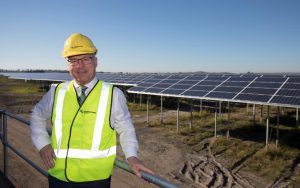Local governments are increasingly adopting corporate emissions reduction targets but are challenged by a lack of resourcing, report finds.
When Sunshine Coast Council flicked the switch on its solar farm last July it became the first local government in Australia to offset its entire electricity consumption across all its facilities and operations from renewables.
Sunshine Coast Council says its striving to become Australia’s most sustainable region and the solar farm, which was recognised in the National Awards for Local Government last week, is a key of its plan to realise that vision.
The solar farm, which is expected to provide $22 million in savings over 30 years, is among the initiatives highlighted in a new report canvassing how Australian councils are tackling climate change, as well as the barriers and challenges they face.
The analysis, produced by think tank Beyond Zero Emissions, global network ICLEI and consultancy Ironbark Sustainability, also highlights Bundaberg Regional Council’s energy efficiency work with Bundaberg Airport, which has brought about a 15 per cent reduction in electricity costs year-on-year since 2015.
Based on a survey of 98 local governments and a review of the websites of all 537 councils, the analysis found most councils had corporate emissions reduction strategies and/or policies, with energy audits of buildings and solar installations among the most common measures being adopted.
The survey found 56 per cent of the councils had a corporate emissions reduction target and a further 25 per cent stated they intended to have one. Almost three quarters (72 per cent) had a corporate emissions baseline inventory while two thirds (64 per cent) had corporate emissions reduction strategies or plans in place.
“Measures that had already been implemented to reduce corporate emissions included energy audits of large facilities (92 per cent), installing solar PV on council facilities (97 per cent) and upgrading lighting in council facilities (93 per cent).”
The review of council websites found that half presented information addressing climate change while 48 per cent detailed actions focusing on reducing or saving energy. Some 42 per cent of all websites presented information about current strategies, actions or plans to reduce emissions.
Most of the councils (70 per cent) reported working in partnership with local community organisations on energy initiatives and over half (53 per cent) worked with their state’s local government association.

Funding, resourcing among the barriers
The analysis found that a lack of funding and resourcing are the most significant barriers to reducing emissions in both corporate and community efforts.
It found many councils had no official budget allocated to reduce emissions, and the scale of investment, related costs and emissions outcomes “are not well understood.”
The report concludes that local government has a clear role in reducing corporate emissions and there is growing interest in reducing community emissions as well.
But it says state governments with their own emissions reduction targets will need to engage with local governments and the wider community to meet these goals.
The report recommends that councils start or continue to set ambitious targets to reduce corporate emissions, measure corporate and community emissions and set community targets in collaboration with local stakeholders.
It also calls on state and territory governments to legislate emissions reductions targets for maximum effect and support councils and communities to access annually updated corporate and community emissions inventories.
Comment below to have your say on this story.
If you have a news story or tip-off, get in touch at editorial@governmentnews.com.au.
Sign up to the Government News newsletter.




Leave a Reply